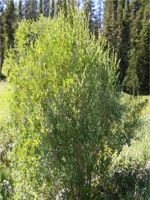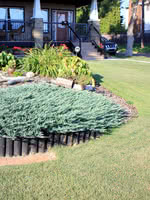Mon-Fri 9am - 5pm Mountain time
Creeping Juniper vs Bebbs Willow
Salix bebbiana
Juniperus horizontalis
NOT AVAILABLE THIS SEASON - MIGHT RETURN
This large shrub is native to all of Canada and most of the United States. Its leaves are green on the top and grey on the bottom, and it produces catkin based flowers and non-edible fruit which appears very similar to a group of pine needles.
Bebb's Willow is foraged for by many species including elk, hares, beavers and various birds. It is commonly used to prevent erosion and protect aquatic environments due to its preference for shady, moist environments.
Creeping Juniper is a low maintenance, spreading, ground cover shrub capable of growing in some of the worst soil and rocky conditions.
You will love this shrubs' pleasant fragrance and year-round color. A beautiful accent or foundation plant, Creeping Juniper has scaly foliage and is commonly used by landscapers to add texture under trees or flower beds. Consider planting Creeping Juniper in areas where grass is difficult to mow or maintain.

